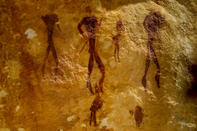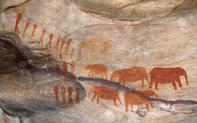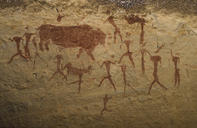Do or Die

Lifestyle Changes

The /Xam San were hunter-gatherers, which meant that they used the indigenous plants and animals for all their needs as they grew no crops and kept no herds. With the very limited resources at their disposal, they took refuge in the caves and ravines in the mountains. Some of those that survived the skirmishes moved northwards to the Kalahari, where the Kung or Northern San live today.
As the years passed, the /Xam became increasingly marginalized and ceased to exist as a tribe. Many of these people became farm hands or domestic servants and added to the gene pool or our modern South African society. These people were South Africa’s first freedom fighters, but their cause was not recognised during the colonial heyday and they have gone forever.
Info Recorded

It is due to a fortunate quirk of fate that we have such a wealth of information about the San people and their paintings. Three /Xam San men who had been living in the North-Western Cape in the second half of the nineteenth century inadvertently provided valuable testimony about the rock art tradition of their vanishing people.
The written records of the San folklore, their beliefs and life stories were compiled by German philologist Dr Wilhelm Bleek and his sister-in-law Dr Lucy Lloyd in Cape Town in the 1870’s and 1880’s. Fascinated by reports of San raids on colonists’ herds, Bleek interviewed these men who had been imprisoned at the Breakwater prison in Cape Town for crimes ranging from stock theft to murder.
He later got permission from the governor for some of the prisoners and their wives to live at home with his family at their home in Observatory, Cape Town. This afforded him and Dr Lloyd the opportunity to compile a comprehensive study on their culture.
Lost Traditions Explained

Dr Bleek died and the family went back to Europe but returned to South Africa in 1904. Lucy Lloyd taught her niece, Dorothea Bleek to continue documenting the San culture, but when she travelled to Prieska and Kenhardt to look up the families of the people that they had known, she found that the descendants of the /Xam there no longer lived in the traditional way.
They no longer knew the language and could not remember the clan stories. Prof David Lewis-Williams of the University of the Witwatersrand and Patricia Vinnicombe were the first to relate this detailed and largely forgotten record, plus a few other historic accounts of San beliefs, to the rock art. He says, “When I began going into this, I could hardly believe the detailed fit.
It was convincing.” This was during the 1960’s, and Professor Lewis-Williams went to the Kalahari Desert in Botswana to interview some of the remaining Northern Kung San hunter-gatherers. Despite having no painting tradition and speaking a different language, their religious beliefs were essentially very similar, and they gave similar explanations to copies of rock paintings as the /Xam San men interviewed by Bleek and Lloyd.
Professor Lewis-Williams concluded that the artists were shamans and the paintings reflected an altered state of consciousness. This incredible insight has helped us to understand and appreciate the rich legacy of San rock art, and we owe this wealth of knowledge to those hapless, long-dead prisoners and the patient researchers who recorded their tales.
Iziko/The South African Museum in Cape Town has a superb exhibition showcasing this history, as well as magnificent examples of San Rock Art.By Louise Brodie